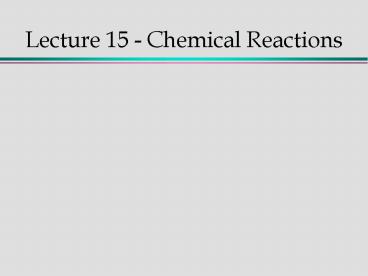Lecture 15 Chemical Reactions - PowerPoint PPT Presentation
1 / 23
Title:
Lecture 15 Chemical Reactions
Description:
The anion is Cl-, Br-, I- (except Ag , Hg22 and Pb2 compounds) The anion is NO3-, ClO4-, CH3COO ... anion Ksp of Mg salt. Cl- 735 (v. soluble) OH- 1 x 10-11 ... – PowerPoint PPT presentation
Number of Views:70
Avg rating:3.0/5.0
Title: Lecture 15 Chemical Reactions
1
Lecture 15 - Chemical Reactions
2
Precipitation Reactions
- Will the reaction proceed?
- Product must be less soluble than the reagents
- see section 4.4 for solubility rules
3
Things are soluble if
- The cation is Li, Na, K, Rb, Cs, NH4
- The anion is Cl-, Br-, I- (except Ag, Hg22 and
Pb2 compounds) - The anion is NO3-, ClO4-, CH3COO-
4
Uses of precipitation reactions
- 1. determination of Ag in solution
- pitfall
- AgCl(s) Ag(aq) Cl-(aq)
- Ksp Ag Cl- 1.6 x 10-10
1.6 x 10-10
i.e. Ag
Cl-
5
Uses of precipitation reactions
- 2. determination of Ra2 in solution
radioactive decay
238U
226Ra
this is also radioactive
6
Cant measure Ra radiation directly!
Ra2
Ra2
Ra2
Ra2
Ra2
Ra2
Ra2
7
but RaSO4 is only slightly soluble...
RaSO4(s) Ra2(aq) SO4-2(aq) Ksp
Ra2(aq) SO4-2(aq) 2.0 x 10-11 thus,
Ra2(aq) 2.0 x 10-11
SO4-2(aq)
8
- suppose a water sample has
- Ra2 1 x 10-13 mol/L
- and suppose we add H2SO4 until
- SO4-2 1 mol/L
- then Ra2(aq) 2 x 10-11 / 1
- 2 x 10-11 mol/L
- i.e. the Ra stays in solution!
9
234Th4(aq) (radioactive)
BaCl2(aq) H2SO4(aq)
Ra2
Ra2
Ra2
Ra2
Ra2
Ra2
Ra2
10
- Ba2(aq) SO4-2(aq) BaSO4(s) (lots!)
- AND
- Ra2(aq) SO4-2(aq) RaSO4(s)
- AND
- Th4(aq) 2 SO4-2(aq) Th(SO4)2(s)
11
Ba(Ra)(Th)SO4(s)
Th radiation
Ra radiation
12
- 1. Measure Ra radiation
- 2. Measure Th radiation indication of how
complete the precipitation was
13
e.g. Uranium Processing
- U ore
- UO22(aq)
- (NH4)2U2O7(s)
acid
NH4OH
U concentrate for shipping
14
e.g. production of Polyvinyl Chloride (PVC)
- ethylene
- vinyl chloride
- PVC
chlorine
15
wheres the Cl2 from?
- brine (sea water)
- Cl2 NaOH
electrolysis
but brine is a solution of many salts!
16
Mg2(aq) and Ca2(aq) interfere with electrolysis!
- anion Ksp of Mg salt
- Cl- 735 (v. soluble)
- OH- 1 x 10-11
- CO3- 1 x 10-5
- SO4-2 752
17
Mg2(aq) and Ca2(aq) interfere with electrolysis!
- anion Ksp of Ca salt
- Cl- 1210
- OH- 6 x 10-6
- CO3- 5 x 10-9
- SO4-2 2 x 10-5
18
thus, add OH- and CO3-2
NaOH(aq)
Na2CO3(aq)
brine
NaCl(aq)
Mg(OH)2(s)
CaCO3(s)
19
2. Acid Base Reactions
- stay tuned!
- in general, acid base salt water
20
3. Oxidation Reduction Reactions
- REDOX, for short
- a transfer of electrons takes place
- one substance gets REDuced, the other gets
OXidized - cant have one without the other!
21
e.g. Na H2O
- overall,
- Na(s) H2O Na(aq) OH-(aq) ½ H2(g)
22
e.g. Na H2O
- actually,
- Na(s) Na(aq) e- (Na gets oxidized)
- H2O e- OH-(aq) ½ H2(g) (H2O gets reduced)
23
e.g. dissolving copper
- Cu(s) HNO3(aq) Cu2(aq) N2O4(g)
- Cu(s) Cu2 2 e- (copper gets oxidized)
- 2 NO3-(aq) 4 H(aq) 2 e- N2O4(g) 2 H2O
(nitrate gets reduced)

